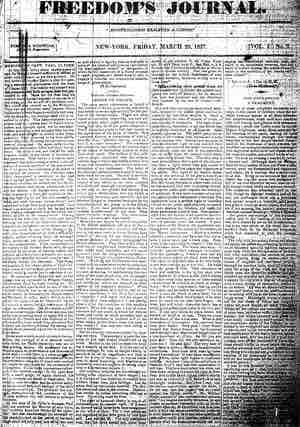A "free Negro" (or "free black"), was the term used prior to the abolition of slavery in the United States to describe African Americans who were not slaves. Almost all African Americans came to the United States as slaves, but from the onset of American slavery, slaveholders freed both male and female slaves for various reasons. Sometimes the heirs of deceased slave owners did not want slaves. In other instances, slaves were freed as a reward for good service, and others still were able to pay slaveholders money in exchange for their freedom. Free blacks during the antebellum era—which began with the formation of the Union (1781) and ended with the outbreak of the Civil War (1860)—were very outspoken about the injustice of slavery.
Free blacks in America were first documented in 1662 in Northampton County, Virginia. By 1776, approximately eight percent of African Americans were free.
In the years following the American Revolutionary War (1783–1810), a number of slaveholders in both the North and Upper South, many of whom were inspired by the Revolution's ideals, freed their slaves. Quakers and Moravians in Virginia, Maryland, and Delaware were also influential in persuading slaveholders to free their slaves. In the Upper South, the percentage of free blacks soared from one percent before the Revolution to 10 percent by 1810. By 1860, on the eve of the American Civil War, the nationwide percentage of free blacks remained at 10 percent, but included 45.7 percent of blacks in Maryland, as well as a whopping 91 percent of blacks in Delaware.
Black men enlisted as soldiers and fought in the American Revolution and the War of 1812. Some owned land, homes, and businesses, and paid taxes. In some Northern cities, blacks were even able to vote. Blacks were also outspoken in print, as Freedom's Journal, the first black-owned newspaper, surfaced in 1827. This paper, as well as other early pieces written by blacks, challenged racist conceptions about the intellectual inferiority of African Americans, and added further fuel to the attack on slavery.
Many free African-American families in colonial North Carolina and Virginia became landowners. Ironically, some also became slave owners. Some did so with the intention of protecting family members by purchasing them from their previous owners. Others, however, participated fully in the slave economy. Freedman Cyprian Ricard, for example, purchased an estate in Louisiana that included 100 slaves.
Planters who had mixed-race children sometimes arranged for their children's education (sometimes even in Northern schools) or their employment as apprentices in crafts. Other planters settled property for their children, while others still simply freed their children and their respective mothers altogether. Though fewer in number than in the Upper South, free blacks in the Deep South (especially in Louisiana and Charleston, South Carolina) were also often mixed-race children of wealthy planters. As such, they too had more opportunities to accumulate wealth. Sometimes they were granted transfers of property and social capital. For instance, Wilberforce University, founded in Ohio in 1856 by Methodist and African Methodist Episcopal (AME) representatives for the education of African-American youth, initially received most of its funding from wealthy southern planters who wanted to pay for the education of their mixed-race children.
Many blacks who were elected as either state or local officials during the Reconstruction era in the South had been free in the South prior to the Civil War. Additionally, many educated blacks whose families had long been free in the North moved South to work and help their fellow freedmen.
Notable free people of color include the following:
- Frederick Douglass, an American slave who escaped to the North, earned his education, and led the abolitionist movement in the United States.
- John Swett Rock, born free in New Jersey ca. nineteenth century; worked as a teacher, doctor, lawyer, and abolitionist, and was the first black admitted to the U.S. Supreme Court Bar.
- James Forten, born free in Philadelphia; became a wealthy businessman (sail maker) and strong abolitionist.
- Charles Henry Langston, abolitionist and activist in Ohio and Kansas.
- John Mercer Langston, abolitionist, politician, and activist in Ohio, Virginia, and Washington, D.C.; first dean of Howard University Law Department; first president of Virginia State University; and in 1888, the first black elected to U.S. Congress.
- Robert Purvis, born free in Charleston; became an active abolitionist in Philadelphia, supported the Underground Railroad, and used his inherited wealth to create services for African Americans.
- John Chavis, born free ca. 1762 in North Carolina; was a teacher and a preacher among both white and free blacks until the mid-nineteenth century when laws became stringent.
- Thomas Day, born free ca. 1801 in Virginia; was a famous furniture maker/craftsman in Caswell County, North Carolina.

Freedom's Journal
Freedom's Journal was the first African-American owned and operated newspaper published in the United States.